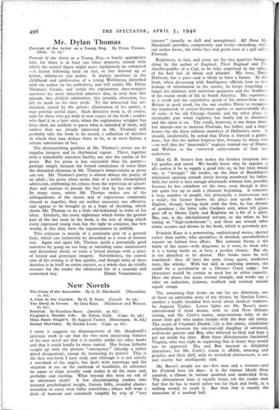Mr. Dylan Thomas
Portrait of the Artist as a Young Dog. By Dylan Thomas. (Dent. 7s. 6d.)
Portrait of the Artist as a Young Dog—a barely appropriate title, for there is at least one other domestic animal with which the central figure might more legitimately be compared —is fiction following hard on fact, or fact dressed up as fiction, whichever you prefer. It depicts incidents in the childhood and adolescence of a young Welshman, identified with the author by his publishers, and will enable Mr. Dylan Thomas's friends, and (while the explanatory dust-wrapper survives) his more detached admirers also, to note how this episode, this childish admiration, this juvenile obsession, has left its mark on his later work. To the interested but un- initiated, teased by the private allusiveness of his poetry, it may provide useful clues. Such detective work is, of course, only for those who get hold of new copies of the book ; readers who find it in a later state, when the explanatory wrapper has been shed, are unlikely to guess what is intended of them, and (unless they are already interested in Mr. Thomas) will probably take the book to be merely a collection of sketches in which they may deduce there to be, as in most fiction, a certain substratum of fact.
The distinguishing qualities of Mr. Thomas's poetry are its singular imagery and its rhythmical vigour. These, together with a remarkable narrative facility, are also the merits of his prose. But his prose is less successful than his poetry— perhaps simply because the formal restrictions of verse limit the rhetorical elements in Mr. Thomas's temperament as prose can not. Mr. Thomas's poetry is almost always the poetry of an adult ; his prose often seems that of a newly emancipated adolescent, celebrating his release from the repression of school- days and anxious to parade the fact that he has no taboos. In many cases, where Mr. Thomas makes use of the colloquialisms of the streets and of expressions commonly classed as impolite, they are neither necessary nor effective, and appear to be brought in in a hope of shocking, which shows Mr. Thomas to be a little old-fashioned in some of his ideas. Similarly, the erotic nightmare which forms the greater part of the last story in the book, is the sort of thing which every repressed young man has the right to compose, but few would, at this date, have the ingenuousness to publish.
This criticism is merely of a particular part of a general fault, which can inclusively be described as a want of literary tact. Again and again Mr. Thomas spoils a potentially good narrative by going on too long or intruding some unnecessary and discordant detail, or ruins a lyrical passage with a piece of forced and grotesque imagery. Nevertheless, the central core of his writing is of fine quality, and though none of these sketches is in itself an entire success, as a whole they do vividly recreate for the reader the adolescent life of a neurotic and














































 Previous page
Previous page